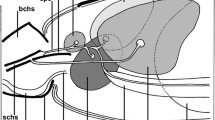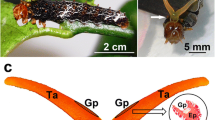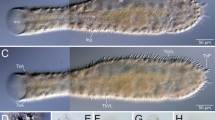Summary
The prothoracic glands, source of the molting hormone ecdysone, regress within a few days after the final molt, a process which was analyzed with electron microscopic methods in the cockroaches Leucophaea and Blaberus. This strictly timed event is accompanied by drastic alterations in cellular fine structure. Early signs of breakdown appear in groups of nuclei whose substance becomes segregated into patches of contrasting electron density characteristic of pyknosis.
The most conspicuous change in the cytoplasm of parenchymal cells concerns the appearance of large, heterogeneous inclusion bodies in which various cellular elements become segregated. These compartments seem to represent autophagic vacuoles within which the gradual degradation of much of their contents takes place, presumably under the influence of lysosomal enzymes. Undigested swirls of membranous character may remain sequestered within these packets for some time.
At advanced stages of cellular atrophy, plasma membranes and nuclear envelopes have gradually disappeared, and masses of protoplasm undergoing autolysis become invaded by a greater number of hemocytes than are present in nymphal glands. These phagocytic elements appear to engulf debris of parenchymal cells as well as some degenerating connective tissue elements. After the completion of the regressive process, the axial band of musculature characteristic of the nymphal gland persists on its own. Whether or not some parenchymal cells (or possibly their precursors) capable of reactivation persist in the proximity of this muscle is unknown.
The resorption of the prothoracic gland in the newly emerged insect is the result of physiological autolysis and seems to be aided by the activity of phagocytic hemocytes.
Similar content being viewed by others
References
Ashford, T. P., and K. R. Porter: Cytoplasmic components in hepatic cell lysosomes. J. Cell Biol. 12, 198–202 (1962).
Bertolini, B.: The structure of the liver cells during the life cycle of a brook-lamprey (Lampetra zanandreai). Z. Zellforsch. 67, 297–318 (1965).
Bonneville, M. A.: Fine structural changes in the intestinal epithelium of the bullfrog during metamorphosis. J. Cell Biol. 18, 579–597 (1963).
Brandes, D., D. E. Buetow, F. Bertini, and D. B. Malkoff: Role of lysosomes in cellular lytic processes. I. Effect of carbon starvation in Euglena gracilis. Exp. molec. Path. 3, 583–609 (1964).
- B. Schofield, and S. Barnard: Lysosomes and focal degradation during prostatic involution. Proceedings — 23rd Ann. Mtg. El. Micr. Soc. Am. August, 1965.
Deane, H. W., and S. Wurzelmann: Electron microscopic observations on the postnatal differentiation of the seminal vesicle epithelium of the laboratory mouse. Amer. J. Anat. 117, 91–133 (1965).
Duve, C. de: From cytases to lysosomes. Fed. Proc. 23, 1045–1049 (1964).
Gilbert, L. I.: Physiology of growth and developement: endocrine aspects. In: The physiology of insecta, edit. by M. Rockstein, vol. I. p. 148–225, 1964.
Hodgson, E. S., and S. Geldiay: Experimentally induced release of neurosecretory materials from roach corpora cardiaca. Biol. Bull. 117, 275–283 (1959).
Lennep, E. W. van, and L. M. Madden: Electron microscopic observations on the involution of the human corpus luteum of menstruation. Z. Zellforsch. 66, 365–380 (1965).
Locke, M., and J. V. Collins: Structure and origin of cytolysomes in an insect. (Abstract). El. Micr. Soc. Am., 23rd Ann. Meeting, Proceedings, D 11, p. 8, 1965.
Lockshin R. A., and C. M. Williams: Programmed cell death-II. Endocrine potentiation of the breakdown of the intersegmental muscles of silkmoths. J. Ins. Physiol. 10, 643–649.
Misch, D. W.: Electron microscope study of alterations in subcellular structure of metamorphosing insect intestinal cells. Anat. Rec. 151, 465–466 (1965).
Novikoff, A. B.: Lysosomes in the physiology and pathology of cells: contributions of staining methods. In: Lysosomes, ed. by A.V.S. de Rueck and M. P. Cameron. Ciba Found. Symp. pp. 36–77. Boston: Little, Brown & Co. 1963.
—, and S. Goldfischer: Nucleosidediphosphate activity in the Golgi apparatus and its usefulness for cytological studies. Proc. nat. Acad. Sci. (Wash.) 47, 802–810 (1961).
Osinchak, J.: Electron microscopic localization of acid phosphatase and thiamine pyrophosphatase activity in hypothalamic neurosecretory cells of the rat. J. Cell Biol. 21, 35–47 (1964).
—: The electron microscopic localization of acid phosphatase and thiamine pyrophosphatase activity in prothoracic glands of the insect Leucophaea maderae. Anat. Rec. 151, 395 (1965).
Reynolds, E. S.: The use of lead citrate at high pH as an electron-opaque stain in electron microscopy. J. Cell Biol. 17, 208–212 (1963).
Scharrer, B.: The prothoracic glands of Leucophaea maderae (Orthoptera). Biol. Bull. 95, 186–198 (1948).
—: Histophysiological studies on the corpus allatum of Leucophaea maderae. IV. Ultrastructure during normal activity cycle. Z. Zellforsch. 62, 125–148 (1964a).
—: The fine structure of the blattarian prothoracic glands. Z. Zellforsch. 64, 301–326 (1964b).
—: An ultrastructural study of cellular regression as exemplified by the prothoracic gland of Leucophaea maderae. Anat. Rec. 151, 411 (1965a).
—: Hemocytes within prothoracic glands of insects. Amer. Zool. 5, 235–236 (1965b).
—: Recent progress in the study of neuroendocrine mechanisms in insects. Arch. Anat. micr. 54, 331–342 (1965c).
Scheib, D.: Structure fine du canal de Müller de l'embryon de Poulet: lésions cytoplasmiques du canal mâle en régression. C. R. Acad. Sci. (Paris) 260, 1252–1254 (1965).
Weber, R.: Ultrastructural changes in regressing tail muscles of Xenopus larvae at metamorphosis. J. Cell Biol. 22, 481–487 (1964).
Author information
Authors and Affiliations
Additional information
Dedicated to Professor W. Bargmann on his 60th birthday in friendship and admiration.
This study was supported by Research Grants AM-03984, NB-02145 and NB-05219 from the U.S.P.H.S.
I wish to express my thanks to Mrs. S. Wurzelmann, Mrs. C. Jones, Mrs. C. Grubman, and Mr. S. Brown for their excellent technical assistance.
Rights and permissions
About this article
Cite this article
Scharrer, B. Ultrastructural study of the regressing prothoracic glands of blattarian insects. Z.Zellforsch 69, 1–21 (1966). https://doi.org/10.1007/BF00406264
Received:
Issue Date:
DOI: https://doi.org/10.1007/BF00406264




